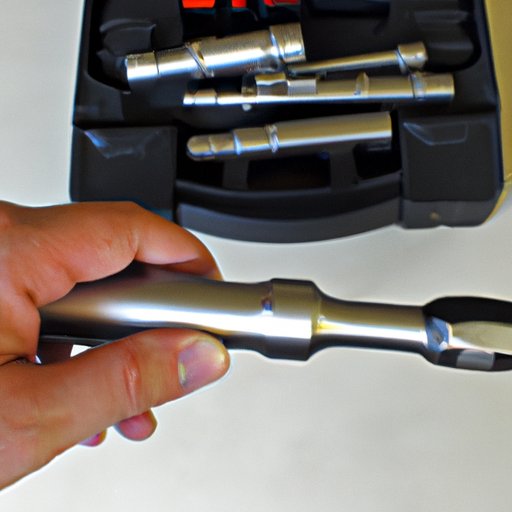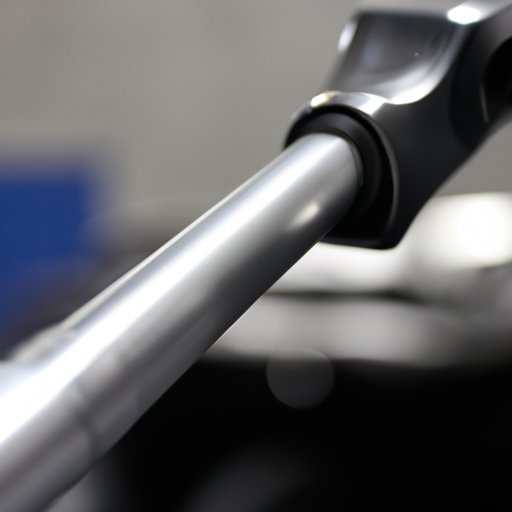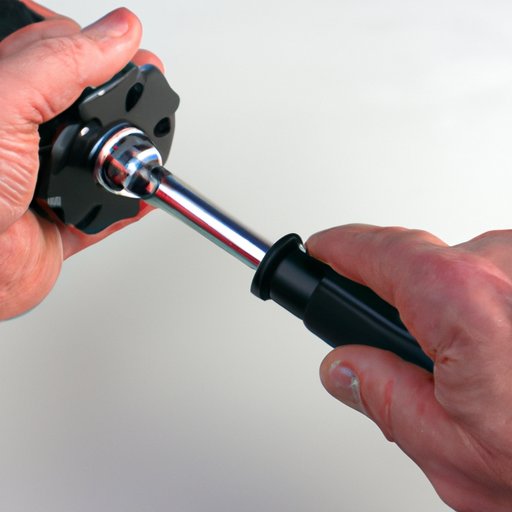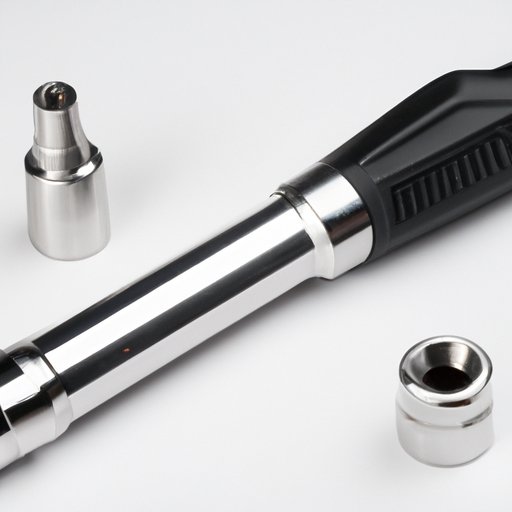Introduction
A torque wrench is a specialized tool used to tighten fasteners, such as nuts and bolts, to a specific torque setting. By using a torque wrench, you can ensure that the fastener is tightened properly without risking overtightening or under-tightening, which could lead to damage or failure of the component.
The purpose of using a torque wrench is to ensure that the fastener is tightened to the correct level with the proper amount of torque. This helps to prevent damage to the component and ensure that it is securely held in place.
Step-by-Step Guide to Using a Torque Wrench
Using a torque wrench is relatively simple, but it does require some preparation and understanding of the principles behind its operation. Here is a step-by-step guide to using a torque wrench correctly:
1. Preparing the Torque Wrench
Before using the torque wrench, check to make sure it is in good working condition. Ensure that the handle and ratchet are functioning properly and that the head of the torque wrench is clean and free of dirt and debris.
2. Setting the Desired Torque Level
Most torque wrenches have a dial or knob on the side that can be used to set the desired torque level. Typically, this is measured in pound-feet (lb-ft) or Newton-meters (Nm). Make sure to set the desired torque level before attaching the torque wrench to the fastener.
3. Attaching the Torque Wrench to the Fastener
Once the desired torque level has been set, attach the torque wrench to the fastener. Make sure to firmly secure the torque wrench to the fastener to ensure accuracy.
4. Tightening the Fastener to the Desired Torque Setting
To tighten the fastener to the desired torque setting, turn the handle of the torque wrench until it clicks. The click indicates that the fastener has been tightened to the desired torque setting.
5. Releasing the Torque Wrench from the Fastener
Once the fastener has been tightened to the desired torque setting, release the torque wrench from the fastener. Make sure to store the torque wrench in a safe place when not in use.
Principles Behind Torque Wrench Operation
Understanding the basic principles behind torque wrenches can help you to better understand how they work and why they are so important for safely and accurately tightening fasteners.
Overview of How Torque Wrenches Work
At its most basic level, a torque wrench works by allowing you to apply a specified amount of force to a fastener. This is done by turning the handle of the torque wrench, which transmits the force to the fastener through the head of the torque wrench. When the torque setting is reached, the torque wrench will click, indicating that the fastener has been tightened to the desired torque setting.
Explaining the Concept of Torque and How It Relates to Tightening Fasteners
Torque is a measure of the amount of rotational force applied to an object. In the case of a torque wrench, the torque is measured in pound-feet (lb-ft) or Newton-meters (Nm). Applying too much torque to a fastener can cause it to be over-tightened, resulting in damage or even failure of the component. Conversely, applying too little torque can result in the fastener being under-tightened, leading to a loose connection and potential safety risks. By using a torque wrench, you can ensure that the fastener is tightened to the correct torque setting.
Different Types of Torque Wrenches
There are several different types of torque wrenches available, each designed for different applications. Here is an overview of the different types of torque wrenches:
Ratcheting Torque Wrenches
Ratcheting torque wrenches are the most common type of torque wrench. They are designed to be used with a ratcheting motion, meaning that the handle can be turned back and forth in a circular motion rather than having to be rotated in a continuous motion. This makes it easier to apply the correct amount of torque to the fastener.
Electronic Torque Wrenches
Electronic torque wrenches are a more advanced type of torque wrench. They are designed to be used with an electronic measuring device, which allows for more precise measurements of the torque applied to the fastener.
Dial Torque Wrenches
Dial torque wrenches are similar to ratcheting torque wrenches, but they feature a built-in dial that allows you to easily set the desired torque level. This makes them ideal for jobs where accuracy is paramount.
How to Select the Right Torque Wrench for Your Needs
Selecting the right type of torque wrench for your needs is important to ensure that you are able to safely and accurately tighten fasteners. Here are some tips for selecting the right type of torque wrench:
Considering the Size of the Job
The size of the job will determine which type of torque wrench is best suited for the task. For small jobs, a ratcheting torque wrench may be sufficient, while larger jobs may require an electronic or dial torque wrench for greater accuracy.
Understanding the Torque Requirements
It is important to understand the torque requirements of the job before selecting a torque wrench. Most fasteners will have a recommended torque setting, which should be used as a guide when selecting a torque wrench.
Deciding on Manual or Electronic Operation
When selecting a torque wrench, you should also consider whether manual or electronic operation is best for the job. Manual torque wrenches are typically less expensive, but they require more skill to use correctly. Electronic torque wrenches are more expensive, but they provide greater accuracy and precision.

Tips for Properly Storing and Maintaining a Torque Wrench
Properly storing and maintaining a torque wrench is important to ensure its accuracy and longevity. Here are some tips for properly storing and maintaining a torque wrench:
Cleaning and Oiling the Torque Wrench Regularly
It is important to regularly clean and oil the torque wrench to ensure that it is in proper working condition. This will help to maintain the accuracy of the torque readings and extend the life of the tool.
Ensuring the Accuracy of the Torque Wrench Readings
It is also important to periodically check the accuracy of the torque wrench readings. This can be done by using a calibration device, which can be purchased from most hardware stores or online.
Careful Storage of the Torque Wrench When Not in Use
Finally, when storing the torque wrench, make sure to store it in a cool, dry place away from direct sunlight. This will help to ensure the accuracy of the torque readings and prolong the life of the tool.

The Benefits of Using a Torque Wrench in Automotive Repair
Using a torque wrench is essential for automotive repair, as it ensures that fasteners are tightened to the correct torque setting. This helps to improve safety during repairs and reduce the risk of overtightening, which can lead to damage or failure of the component. Additionally, using a torque wrench can help to increase the accuracy and precision of tightening fasteners, ensuring that they are securely held in place.

Common Mistakes to Avoid When Using a Torque Wrench
There are several common mistakes that people make when using a torque wrench. To ensure that you are using the torque wrench correctly, here are some common mistakes to avoid:
Not Calibrating the Torque Wrench Before Use
It is important to calibrate the torque wrench before each use to ensure accuracy. This can be done by using a calibration device, which can be purchased from most hardware stores or online.
Not Properly Securing the Torque Wrench to the Fastener
Make sure to firmly secure the torque wrench to the fastener to ensure accuracy. If the torque wrench is not properly secured, the readings may not be accurate.
Not Releasing the Torque Wrench After Tightening
Finally, make sure to release the torque wrench after tightening the fastener. This will ensure that the torque wrench is ready for the next time it is used.
Conclusion
A torque wrench is an essential tool for safely and accurately tightening fasteners. Understanding the principles behind torque wrenches and how to use them properly is important for ensuring that fasteners are tightened to the correct torque setting. There are several different types of torque wrenches available, each designed for different applications. It is important to select the right type of torque wrench for your needs, as well as properly store and maintain the torque wrench to ensure accuracy and longevity.
(Note: Is this article not meeting your expectations? Do you have knowledge or insights to share? Unlock new opportunities and expand your reach by joining our authors team. Click Registration to join us and share your expertise with our readers.)
